Leonardo da Vinci, Last Supper, oil, tempera, fresco, 1495–98 (Santa Maria delle Grazie, Milan)
[0:00] [music]
Dr. Steven Zucker: [0:04] We’re in Santa Maria della Grazie in Milan, looking at Leonardo da Vinci’s “Last Supper.”
Dr. Beth Harris: [0:11] We’re in the room where the monks would eat, the refectory, and so several times a day, the monks would come in here and eat silently and be able to look up Leonardo’s “Last Supper.”
Dr. Zucker: [0:19] It’s an ideal place, of course, for this particular subject, and not an uncommon one.
Dr. Harris: [0:24] Let’s talk about the story. At the Last Supper, Christ says, “One of you will betray me,” to his 12 apostles.
Dr. Zucker: [0:31] One of the ways that this painting is often read is not the moment when Christ utters that, but the moment after when the reaction takes place. These are his closest followers.
Dr. Harris: [0:40] We see the shock at hearing these terrible words from Christ. “Is it I?” they ask. “Is it I, Lord, who will betray you?”
Dr. Zucker: [0:48] What we see is this incredible set of reactions from the apostles around the table.
Dr. Harris: [0:53] So that’s one way we can understand the fresco. But there’s another aspect of the narrative.
Dr. Zucker: [0:58] Christ, you can see, is reaching towards both a glass of wine and towards bread. This is the institution of the sacrament.
Dr. Harris: [1:06] The sacrament of the Eucharist, where Christ says, “Take this bread, for this is my body. Take this wine, for this is my blood, and remember me.” You can see that he reaches out toward the bread and the wine.
Dr. Zucker: [1:18] What’s interesting is that Christ’s hand is widely spread. It seems as if he’s reaching towards the wine but at the same time, he’s reaching toward a bowl. At the same moment, Judas is reaching towards that same bowl.
Dr. Harris: [1:31] Judas is the one who’s going to betray Christ. He’s been paid 30 pieces of silver by the Romans. You can see he’s grasped that bag of silver in his right hand as he pulls away from Christ, his face cast in shadow.
Dr. Zucker: [1:45] But he’s pulling away at the same time that he’s still reaching out to the bowl. And that’s one of the ways that Christ identifies who will betray him, the person who shares, who dips with him, in the bowl.
Dr. Harris: [1:54] Leonardo tells us several moments in this story, and at the same time gives us a sense of the divine, eternal importance of this story. We would never mistake this for 13 people having dinner. We know that this is an important moment without any of the obvious symbols of the divine that we would have in the early Renaissance, like the halo.
Dr. Zucker: [2:15] The figures themselves are monumental in this space and too crowded for that table, creating a kind of energy, a kind of chaos that surrounds the perfection, the solemnity, the geometry of Christ.
Dr. Harris: [2:29] Christ forms an equilateral triangle. His head is in the center of a circle. The window that frames his head reads as a halo. There’s that calm center, and then human beings with all of their faults and fears and worries around that divine center.
Dr. Zucker: [2:47] This is Leonardo da Vinci, who is thinking about mathematics. He’s thinking about science. He’s thinking about the integration of all of these things.
Dr. Harris: [2:55] If we look at earlier images of the Last Supper, there’s lots of room at the table. There’s lots of decorations in the room. What Leonardo does is he simplifies everything and focuses us on those figures and their gestures.
[3:08] And by making it so that there’s no room behind the table, the figures take up so much space, it’s separating our world from the world of Christ and the apostles. There’s no way for us to enter that space.
Dr. Zucker: [3:19] In fact, there’s no way for them to move into our space. There really is this demarcation.
Dr. Harris: [3:24] In versions of the Last Supper that Leonardo would have seen in Florence, Judas is sitting on the opposite side of the table. By putting Judas with the other apostles, he does use the table as a barrier between our world and the world of the apostles.
Dr. Zucker: [3:38] Let’s look at those faces for a moment. Christ is so serene. His eyes are down. One hand is up. One hand is down. To his right is a group of three. And there is Judas, who’s facing away from us in shadow. His neck is turned, reminding us that that night he will hang himself.
[3:56] As he pulls away, St. Peter, Christ’s protector, rushes in. He’s got a knife that he holds around his back. He comes in seeming to say, almost, “Who is it? I need to defend you.”
Dr. Harris: [4:07] The third figure in that group with Judas and Peter would be St. John, who looks very resigned and closes his eyes. That’s the tradition in paintings of the Last Supper.
[4:16] My favorite three figures are the figures on the far right. Leonardo was very interested in using the body to reveal the soul, to reveal one’s internal nature. Leonardo was creating these four groups of three, that idea of knitting the figures together, overlapping them with one another, creating all this drama.
Dr. Zucker: [4:36] And creating tensions and contrast between the emotional responses of all these figures. There’s that incredible grouping of Thomas pointing upward.
Dr. Harris: [4:45] As if to say, “Is this something that is ordained by God? Is this God’s plan that one of us should betray you?”
Dr. Zucker: [4:51] But of course, that finger also foreshadows him actually proving Christ’s resurrection by plunging that finger into Christ’s wound. Then we have Philip and James the Major, and they’re in opposition. One throwing his arms out, one bringing his hands together.
Dr. Harris: [5:06] If we were to compare this with earlier Last Suppers, we would see the way that the figures remained very separate from one another. Here, that idea of the unified composition, which is so characteristic of the High Renaissance.
[5:19] What I sense here more than anything is the divinity of Christ here in the center. His calm, the way that all of those perspective lines bring us toward him.
Dr. Zucker: [5:30] It’s interesting because that perspective that the artist is rendering is slightly at odds with the perspective as we see it from down here on the floor. That is, we would need to be close to Christ’s level to see this painting in a perspectively correct manner. It’s interesting; in a sense, it elevates us as we look at this painting.
Dr. Harris: [5:50] Now, keep in mind we’re not seeing this the way that people would have seen it in 1498.
Dr. Zucker: [5:55] The painting is in terrible condition, in part because Leonardo experimented with a combination of oil paint and tempera in an environment where fresco would be traditionally used, and the painting began to deteriorate soon after it was completed.
Dr. Harris: [6:08] Right. Unlike a traditional fresco, which is painted on wet plaster, Leonardo painted on dry plaster, and the paint never really adhered to the wall. Luckily for us, the “Last Supper” has been conserved.
Dr. Zucker: [6:19] In some ways, this is finding a way of creating a sense of the eternal, a sense of the perfect, but within the chaos that is the human experience.
Dr. Harris: [6:28] That’s right. Uniting the earthly and the divine.
[6:30] [music]
Leonardo imagined, and has succeeded in expressing, the desire that has entered the minds of the apostles to know who is betraying their Master. So in the face of each one may be seen love, fear, indignation, or grief at not being able to understand the meaning of Christ; and this excites no less astonishment than the obstinate hatred and treachery to be seen in Judas. Giorgio Vasari, Lives of the Artists, 1568; translated by George Bull
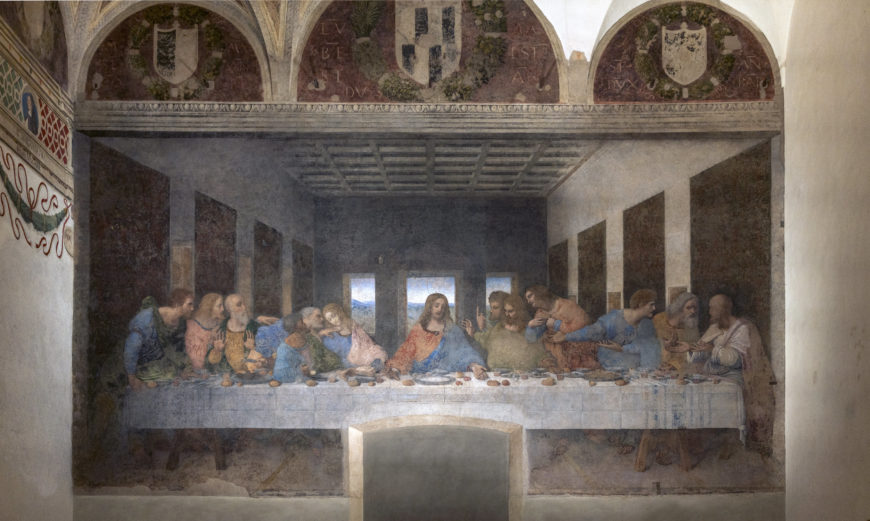
Leonardo da Vinci, Last Supper, oil, tempera, fresco, 1495–98 (Santa Maria delle Grazie, Milan; photo: Steven Zucker, CC BY-NC-SA 2.0)
Subject
The subject of the Last Supper is Christ’s final meal with his apostles before Judas identifies Christ to the authorities who arrest him. The Last Supper (a Passover Seder) is remembered for two events:
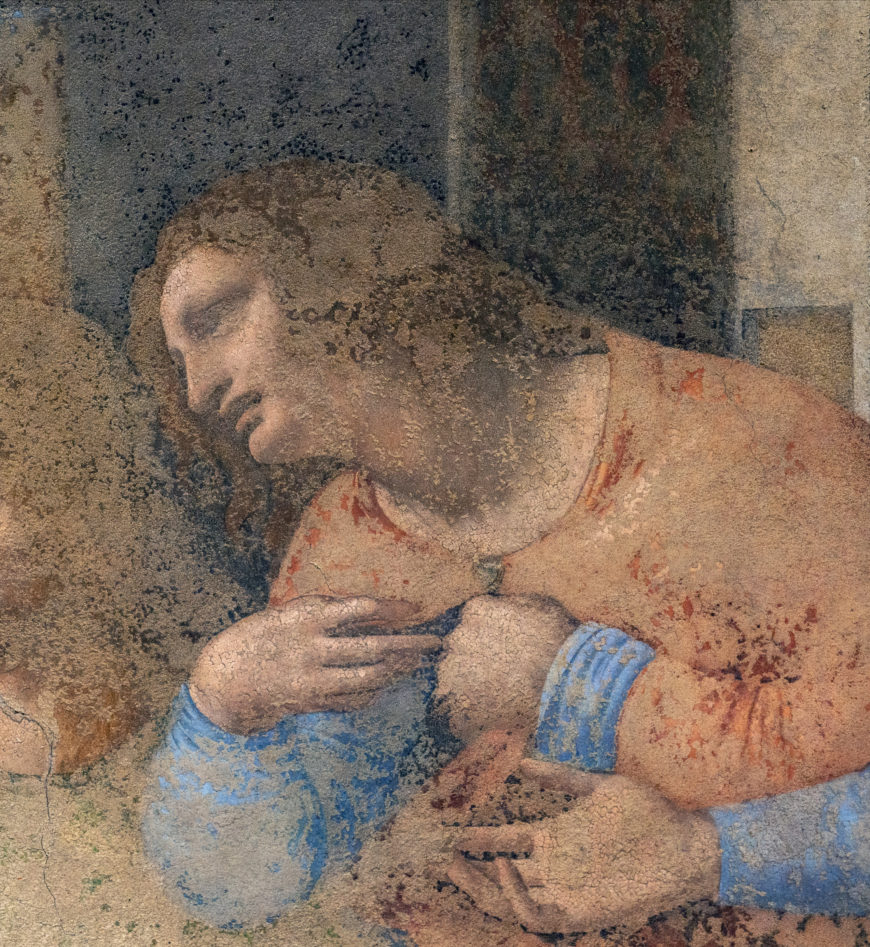
Philip (detail), Leonardo da Vinci, Last Supper, oil, tempera, fresco, 1495–98 (Santa Maria delle Grazie, Milan; photo: Steven Zucker, CC BY-NC-SA 2.0)
Christ says to his apostles, “One of you will betray me,” and the apostles react, each according to his own personality. Referring to the Gospels, Leonardo depicts Philip asking, “Lord, is it I?” Christ replies, “He that dippeth his hand with me in the dish, the same shall betray me” (Matthew 26). We see Christ and Judas simultaneously reaching toward a plate that lies between them, even as Judas defensively backs away.
Leonardo also simultaneously depicts Christ blessing the bread and saying to the apostles, “Take, eat; this is my body” and blessing the wine and saying “Drink from it all of you; for this is my blood of the covenant, which is poured out for the forgiveness of sins” (Matthew 26). These words are the founding moment of the sacrament of the Eucharist (the miraculous transformation of the bread and wine into the body and blood of Christ).
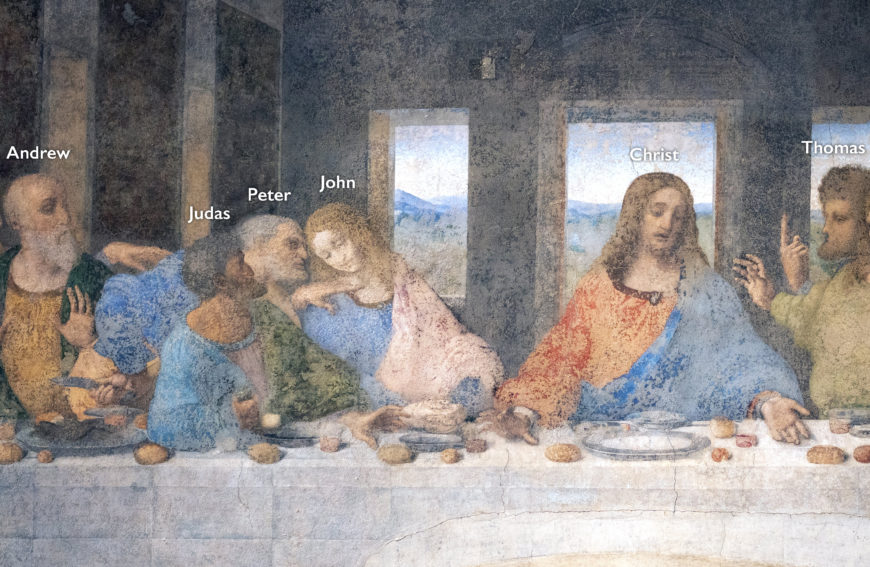
Detail, Leonardo da Vinci, Last Supper, oil, tempera, fresco, 1495–98 (Santa Maria delle Grazie, Milan; photo: Steven Zucker, CC BY-NC-SA 2.0)
Apostles identified
Leonardo’s Last Supper is dense with symbolic references. Attributes identify each apostle. For example, Judas Iscariot is recognized both as he reaches toward a plate beside Christ (Matthew 26) and because he clutches a purse containing his reward for identifying Christ to the authorities the following day. Peter, who sits beside Judas, holds a knife in his right hand, foreshadowing that Peter will sever the ear of a soldier as he attempts to protect Christ from arrest.
Suggestions of the heavenly
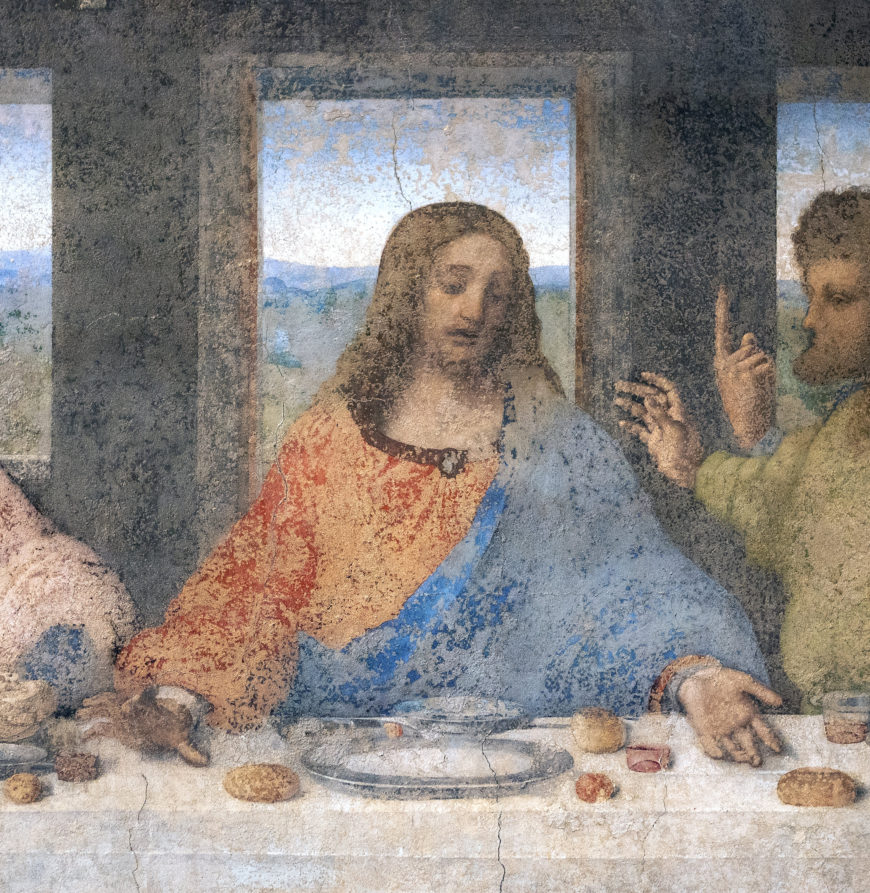
Christ (detail), Leonardo da Vinci, Last Supper, oil, tempera, fresco, 1495–98 (Santa Maria delle Grazie, Milan; photo: Steven Zucker, CC BY-NC-SA 2.0)
The balanced composition is anchored by an equilateral triangle formed by Christ’s body. He sits below an arching pediment that, if completed, traces a circle. These ideal geometric forms refer to the renaissance interest in Neo-Platonism (an element of the humanist revival that reconciles aspects of Greek philosophy with Christian theology). In his allegory, “The Cave,” the Ancient Greek philosopher Plato emphasized the imperfection of the earthly realm. Geometry, used by the Greeks to express heavenly perfection, has been used by Leonardo to celebrate Christ as the embodiment of heaven on earth.
Leonardo rendered a verdant landscape beyond the windows. Often interpreted as paradise, it has been suggested that this heavenly sanctuary can only be reached through Christ.
The twelve apostles are arranged as four groups of three and there are also three windows. The number three is often a reference to the Holy Trinity in Catholic art. In contrast, the number four is important in the classical tradition (e.g. Plato’s four virtues).
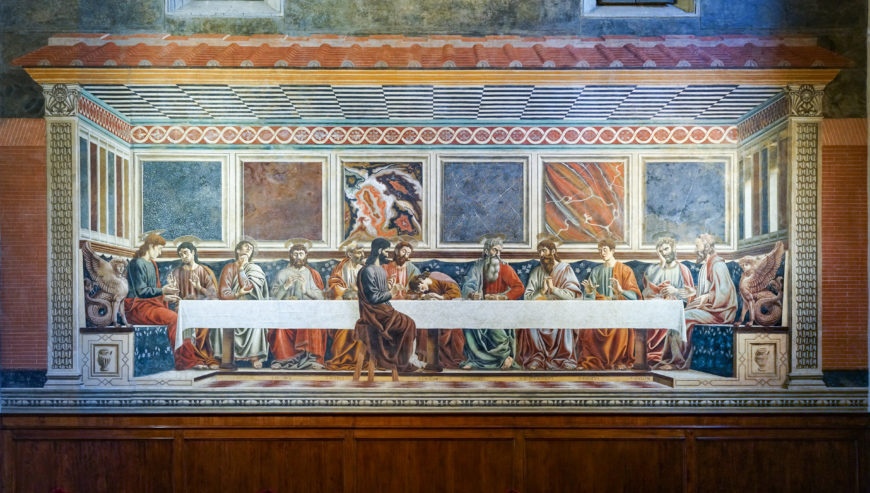
Andrea del Castagno, The Last Supper, 1447, fresco, 453 x 975 cm (refectory of the convent of Sant’Apollonia, now the Museo di Cenacolo di Sant’Apollonia, Florence; photo: Steven Zucker, CC BY-NC-SA 2.0)
The Last Supper in the early Renaissance
Andrea del Castagno’s Last Supper is typical of the early Renaissance. The use of linear perspective in combination with ornate forms such as the sphinxes on the ends of the bench and the marble paneling tend to detract from the spirituality of the event. In contrast, Leonardo simplified the architecture, eliminating unnecessary and distracting details so that the architecture can instead amplify the spirituality. The window and arching pediment even suggest a halo. By crowding all of the figures together, Leonardo uses the table as a barrier to separate the spiritual realm from the viewer’s earthly world. Paradoxically, Leonardo’s emphasis on spirituality results in a painting that is more naturalistic than Castagno’s.
Backstory
During World War II, in August of 1943, the Allies launched a massive bombing campaign on Milan and its outskirts. The explosions and the ensuing fires killed over 700 people and destroyed many of the city’s most important buildings and monuments, including a significant portion of Santa Maria delle Grazie. Miraculously, the wall with the painting survived, probably because it had been shored up with sandbags and mattresses, but the roof of the refectory was blown off and the other walls were decimated. For several months, the Last Supper remained exposed to the elements, covered only with a tarp, until the refectory (the dining room of the monastery where the Last Supper was painted) was rebuilt and a team of restorers began working to preserve and restore the painting.
But Leonardo’s work was already in a sad state well before bombs threatened to destroy it completely. Soon after it was completed on February 9, 1498, it began to deteriorate. Because Leonardo sought greater detail and luminosity than could be achieved with traditional fresco, he covered the wall with a double layer of dried plaster. Then, borrowing from panel painting, he added an undercoat of lead white to enhance the brightness of the oil and tempera that was applied on top. This experimental technique allowed for chromatic brilliance and extraordinary precision but because the painting is on a thin exterior wall, it amplified the effects of humidity, and the paint failed to properly adhere to the wall. Mold grew between the paint and the surface, and the presence of moisture caused constant peeling. By the second half of the sixteenth century, Giovanni Paulo Lomazzo stated that “the painting is all ruined.” The first restoration efforts took place beginning in 1726, and over the centuries they were followed by several more.
Over the past five hundred years the painting’s condition has been seriously compromised by these early restoration efforts, as well as by its location (the church is in an area prone to severe flooding); the materials and techniques Leonardo used; occupation by Napoleon’s army (who stabled horses in the refectory and reportedly lobbed bricks at the apostles’ heads); humidity, dust, and air pollution; and, most recently, the cumulative effect of crowding tourists.
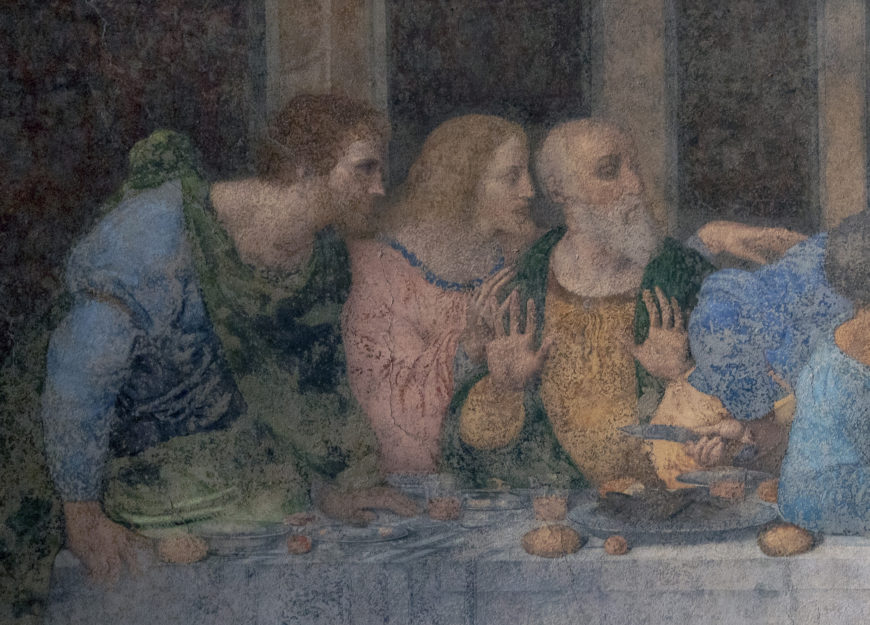
Bartholomew, James Minor, and Andrew (detail), Leonardo da Vinci, Last Supper, oil, tempera, fresco, 1495–98 (Santa Maria delle Grazie, Milan; photo: Steven Zucker, CC BY-NC-SA 2.0)
After the destruction wrought by the bombing in World War II, restorers covered the painting with a thick layer of shellac (a kind of resin) in order to combat the moisture problems and keep the paint from peeling. They then began scraping away some of the layers of paint that had been applied over the years, uncovering what they believed to be Leonardo’s original brushstrokes. Finally, in 1977, the Italian government teamed with private corporations to fund a massive project to fully uncover the original painting. It took head restorer Pinin Brambilla Barcilon over twenty years to complete the effort, meticulously scraping away at the painting’s surface centimeter by centimeter with surgical tools and microscope. In 1999, when the fully restored painting—in its new, climate-controlled environment—was officially unveiled, critics around the globe argued as to whether it is now true to the original, or irrevocably deformed, as only about 42.5% of the present surface is Leonardo’s work, 17.5% is lost, and the remaining 40% was added by previous restorers. (Most of this repainting can be found in the painting’s wall hangings and ceiling).
The Last Supper is a prime example of how public and professional attitudes toward restoration efforts are not only often contentious, but change over time. Whereas in the nineteenth century and earlier, restorations focused on overpainting in order to present the illusion of a perfectly finished work, modern approaches tend to favor the exposure of missing pieces, and to make all additions visible and explicit. The current version of the Last Supper resembles little of what Leonardo created in 1498, but it makes visible the painting’s miraculous and tortured history.
Condition statistics
Number of years after its completion that deterioration was noted: 18
Number of bombs that have hit the refectory: 1
Number of years needed to complete the recent conservation project: 22
Number of years that Leonardo needed to complete the painting: 4
Number of research studies produced during conservation project: 60
Number of hours spent on the conservation project: 50,000
Percentage of the surface that is lost: 17.5
Percentage of the surface painted during the seven previous restorations: 40
Percentage of the surface that was painted by Leonardo: 42.5
Backstory by Dr. Naraelle Hohensee

